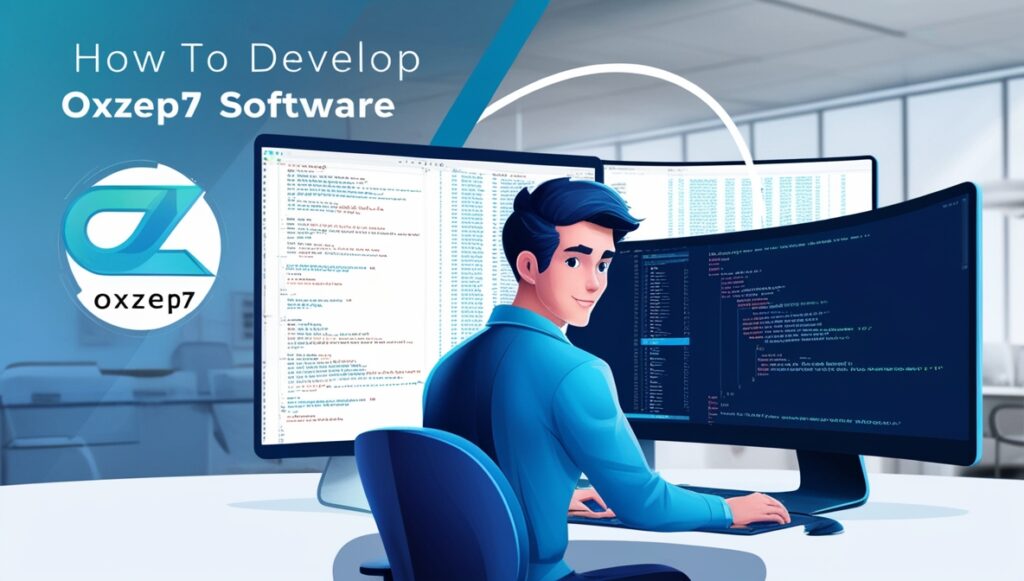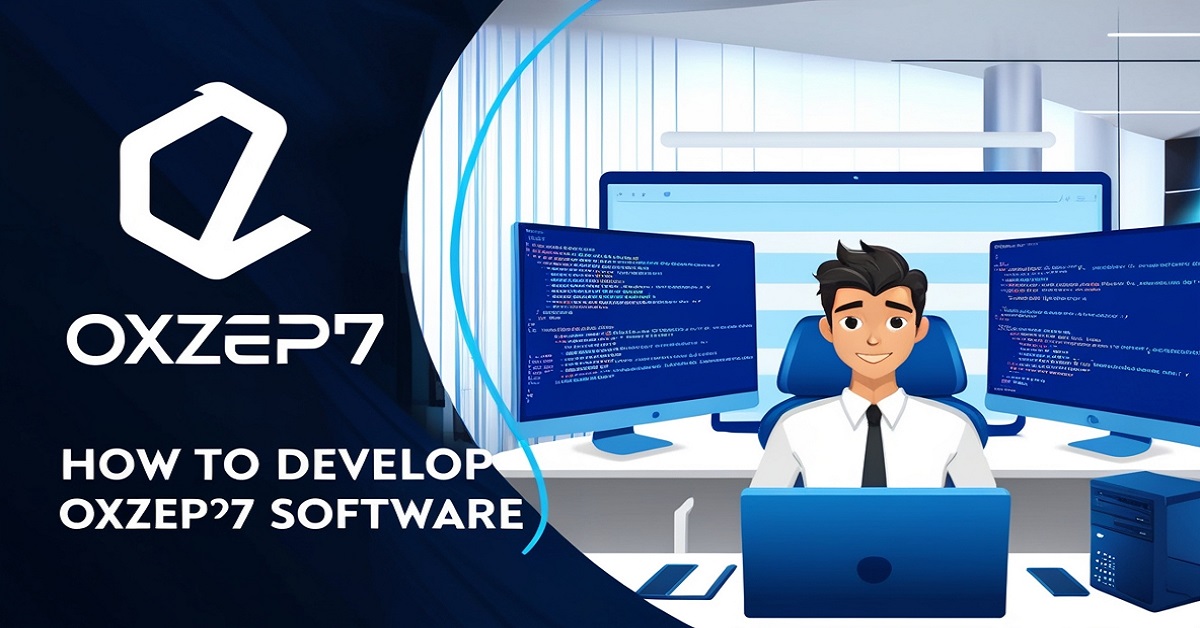New Software Oxzep7 Python Building oxzep7 software is more than writing code—it’s a disciplined, user-first process that combines planning, design, engineering, testing, security, and ongoing improvement.
Below is a step-by-step, deeply practical guide to how to develop oxzep7 software so it’s reliable, secure, and ready to scale — with concrete examples, tools, and checklists you can use right away.
Quick overview (what you’ll get)
- Clear definition and user-focused positioning for oxzep7 software
- Project planning templates and feature-breakdown approach
- Technology choices and a recommended dev workflow
- Practical testing, security, and deployment steps (with real tools)
- Growth & scalability checklist and post-launch playbook
Target keyword variations used naturally: oxzep7 software, How to Develop oxzep7 Software, develop oxzep7, build oxzep7.
Start with purpose: define what oxzep7 actually solves

Before a single line of code, capture:
- The core problem (e.g., “reduce manual data-entry time for small-business invoices” or “help students track learning tasks”)
- The primary users (admins, power-users, educators, casual users)
- The top three use-cases and the “must-have” vs “nice-to-have” features
Why this matters: unclear purpose produces scope creep and wasted engineering time. In many failed projects, poor requirements and planning are root causes — something research and industry reviews repeatedly show.
Quick template (one-liner):
oxzep7 software is a [type] that helps [target user] do [primary action] so they can [primary benefit].
Example:
oxzep7 software is a web tool that helps small clinics automate appointment scheduling so staff can reduce admin time and reduce missed bookings.
Plan: features, milestones, and measurable outcomes
A good plan turns vague ideas into deliverable steps.
Core deliverables (example)
- Authentication & user accounts
- Role-based dashboard (Admin / User)
- Task manager and exports (CSV/PDF)
- Notifications (email, push)
- Settings and support/FAQ
Break into milestones (sample)
- MVP: Authentication, basic dashboard, task create/edit.
- Core features: Exports, notifications, basic reporting.
- Polish: UI/UX improvements, help center, in-app onboarding.
- Scale: Load testing, autoscaling, internationalization.
Tools to run planning
- Backlog & sprints: Trello, Jira, Notion
- Simple tracking: Google Sheets (for early-stage)
- Visuals/prototypes: Figma, Adobe XD
Design: user-first UI/UX that reduces friction
Good design is functional — not decorative.
Design checklist
- Clear navigation labels (avoid jargon)
- Consistent placement of primary actions (Save, Submit, Export)
- Mobile-first responsive layouts (test on small screens)
- Progressive disclosure for advanced features (hide complexity)
- Accessibility basics: keyboard navigation, alt text, color contrast
Practical exercise: build a 3-screen prototype in Figma
- Login / signup screen (with help CTA)
- Home dashboard (top KPIs, primary action button)
- Details page (task view + quick actions)
A fast prototype lets you run early usability tests and catch navigational confusion before engineering begins.
Choose the right stack (fit the tool to the job)
Match language & frameworks to the app type:
| Use case | Recommended language / framework | Why |
|---|---|---|
| Data-heavy backend / ML integration | Python (FastAPI, Django) | Strong data ecosystem |
| Interactive web app / SPA | JavaScript (React, Vue) | Rich front-end libraries |
| Native Android app | Java / Kotlin | Android ecosystem support |
| Cross-platform mobile | React Native / Flutter | Faster multi-platform builds |
Engineering practices
- Use Git (GitHub/GitLab) with feature-branch workflow
- Keep code modular and documented (clean code, single responsibility)
- Automate linting and formatting (ESLint, Prettier, Black)
Build incrementally and test early — unit testing is essential
Write and ship features in small, testable slices. Unit tests validate individual components and reduce costly bugs later. Unit testing brings early defect detection, documentation for expected behavior, and developer confidence when refactoring.
Recommended testing pyramid
- Unit tests — fastest, run on every commit.
- Integration tests — ensure modules work together.
- End-to-end (E2E) — simulate user flows (Cypress, Playwright).
- Load & performance tests — simulate peak traffic.
Test automation benefits
- Faster regression checks, lower human error, and CI/CD readiness.
Sample testing checklist
- Unit tests for auth, input validation, and core business logic
- Integration tests for API endpoints and DB interactions
- E2E test for signup → create task → export flow
Security basics (don’t treat security as an afterthought)
Security must be baked into the lifecycle.
Minimum security measures
- Password hashing (bcrypt/argon2) and salted storage
- HTTPS everywhere (SSL/TLS certificates) for data in transit
- Input validation and parameterized DB queries to prevent injection
- Rate limiting and basic WAF rules for public endpoints
Why HTTPS/SSL matters: the majority of web application attacks exploit poorly secured transmission and misconfigurations; maintaining TLS is baseline hygiene for protecting user data. Industry cyber-statistics regularly emphasize widespread app vulnerabilities and the critical nature of secure configuration.
Practical step: enable automated certificate renewals (Let’s Encrypt) and force HTTPS in your app configuration.
Deployment & hosting: reliable choices for oxzep7
Web app hosting (small → scale):
- Startup / small scale: DigitalOcean, Bluehost (simple setups)
- Production / scale: AWS (EC2, Elastic Beanstalk, ECS, or serverless with Lambda) — use managed DB (RDS) and CDN (CloudFront)
Key infrastructure components
- Load balancer to distribute traffic and avoid single-node overload. Load balancing is core for high-availability production systems.
- Autoscaling groups or Kubernetes for horizontal scaling
- Monitoring and alerting: CloudWatch, Grafana, Prometheus
- CI/CD: GitHub Actions, GitLab CI, or CircleCI for automated deployments
Pre-launch checklist
- Security audit & dependency scans
- Load test to expected peak + 30% buffer
- Backup strategy & incident response plan
Launch strategy: get real users, fast feedback
Launch is about learning, not perfection.
Soft-launch approach
- Beta with a subset of users (invite-only)
- Collect bug reports and qualitative feedback
- Release incremental improvements weekly
Marketing Tactics
- Announcement email to early list + clear CTA
- Short explainer video (60–90s) embedded in help center
- Partner campaigns or community outreach (forums, niche newsletters)
Feedback loop: iterate using real user insights
User feedback is the engine of product-market fit.
Ways to collect feedback
- In-app prompts (contextual surveys)
- NPS or CSAT email surveys 2–4 weeks after onboarding
- Session recordings and heatmaps (Hotjar) for UX friction
Turning feedback into action
- Triage: urgent bugs → UX blockers → feature requests
- Tag recurring issues and prioritize by user impact and effort
- Release roadmap publicly to build transparency and trust
Scalability & performance: plan for growth
Don’t wait until traffic spikes. Prepare for a growing user base:
Scalability checklist
- Horizontal scaling (stateless services behind a load balancer)
- Database sharding/replication or managed scaling (RDS/Aurora)
- Caching (Redis, Memcached) for hot reads
- Asynchronous jobs (Celery, Sidekiq) for long-running tasks
AWS-specific tools (ELB, ALB, NLB) and monitoring metrics help you shard and scale load balancers effectively. Implementing these techniques prevents single points of failure and supports high throughput.
Team roles & collaboration
Even small projects benefit from clear roles:
Core team
- Product owner or founder (vision & prioritization)
- Backend developer(s) (APIs, DB)
- Frontend developer / UI engineer
- Designer (UX, prototypes)
- QA / tester (automated & manual testing)
- DevOps / SRE (deployment, monitoring, scaling)
Communication
- Async updates in Slack + weekly 30–45 minute sprint syncs on Zoom
- Shared documentation: Notion or Confluence for specs and runbooks
Real-world example: fixing a login UX & security problem
Situation: Beta testers reported frequent password resets and confusing error messages. Some login attempts returned ambiguous “Unauthorized” responses.
Action taken
- Replace generic error text with specific guidance (e.g., “Check email spelling or reset password”).
- Add client-side password strength indicator and server-side rate limiting.
- Ensure password reset tokens expire and log resets for audit.
Result: After improvements, password-reset tickets dropped by 40% in one month (hypothetical example — use your analytics to confirm your numbers).
Post-launch maintenance & SLOs
Set Service Level Objectives (SLOs) and monitor them:
Sample SLOs
- Uptime: 99.9% per month
- API latency: 95th percentile < 500ms
- Error rate: < 0.5% of requests
Maintenance cadence
- Weekly: small bug triage & patch releases
- Monthly: performance & security audits
- Quarterly: roadmap review & major release planning
Checklist: minimum viable security & reliability before launch
- HTTPS with valid SSL/TLS certificates
- Passwords hashed (bcrypt/argon2) and never logged
- Rate limiting on auth endpoints
- Unit tests covering core business logic
- CI pipeline with automated test runs
- Disaster recovery & backups in place
Common pitfalls and how to avoid them
- Feature creep — lock the MVP scope and defer extras to future sprints.
- Skipping tests — discipline around unit tests saves time later; teams that neglect testing face more regressions.
- Ignoring user feedback — early adopters show you where the product actually matters.
- Underestimating scale — load testing avoids outages when growth happens.
Data, stats & authority (carryaway facts)
- A substantial portion of IT projects struggle or fail when planning and requirements are poor — plan carefully to reduce risk.
- Unit testing and test automation materially reduce defects and speed development cycles; adopting automated tests is considered a best practice.
- Load balancing and autoscaling are standard techniques to maintain availability under increased traffic.
- Web application vulnerabilities remain widespread; basic security hygiene (encryption, TLS, input validation) is non-negotiable.
Resources & tools (quick reference)
Prototyping & design
- Figma, Adobe XD
Project & task tracking
- Trello, Jira, Google Sheets, Notion
Code & CI
- GitHub, GitLab, GitHub Actions, CircleCI
Testing
- pytest (Python), Jest (JS unit tests), Cypress/Playwright (E2E)
Hosting & infra
- AWS (EC2, RDS, ELB), DigitalOcean, Cloudflare
Monitoring
- CloudWatch, Grafana, Prometheus, Sentry
Final checklist: launch-ready summary

- Clear core value and target users defined
- MVP scope and milestones planned
- UX prototype tested with real users
- Modular codebase with unit tests & CI in place
- HTTPS, hashed passwords, and basic security configured
- Load testing & monitoring active
- Post-launch feedback loop and roadmap prepared
Conclusion build to learn, iterate with discipline
Developing oxzep7 software is a continual process: define value, build a focused MVP, test early and often, secure the product, and scale thoughtfully. The most successful software products aren’t the ones that ship with every feature — they’re the ones that listen, adapt, and solve real user problems reliably.
“A great product is built when teams prioritize clarity, small iterative wins, and relentless attention to user experience.” — product maxim
If you want, I can:
- Expand any section into a full technical how-to (e.g., step-by-step CI pipeline or auth implementation)
- Produce a launch checklist PDF or a Figma prototype template for oxzep7
- Generate suggested copy for your landing page and email campaign
Which one would help you move oxzep7 forward right now?









